The ex-Roman colony today is the fifth largest city on the Croatian coast. Zadar is a medium-sized city that perfectly combines its rich medieval and Roman history with urban architecture and contemporary culture. Being a seaside town, it has a warm Mediterranean climate, stunning beaches, beautiful islands and an abundance of nature.
The city itself has many things to show, from landmarks like the Sea Organ and Greeting to the Sun to the old ancient buildings and monuments. Away from the city centre, there are islands to explore, nature, and national parks to discover. Explore the best things to do in Zadar to please the five senses.
Zadar, Croatia
20 Things To Do In Zadar
1- Explore The Old Town
Zadar is the county’s administrative, economic and educational centre and holds a rich history dating back to 1000 BC.
Being in hands of Romans and Venetians, it carries a little bit of each culture.
On this private walking tour, you can explore all the sites and monuments this city offers, from the Roman forum, Kalelarga, and the church of St. Donat, to the famous Sea Organ and many others.
2- Go Sailing And Snorkelling
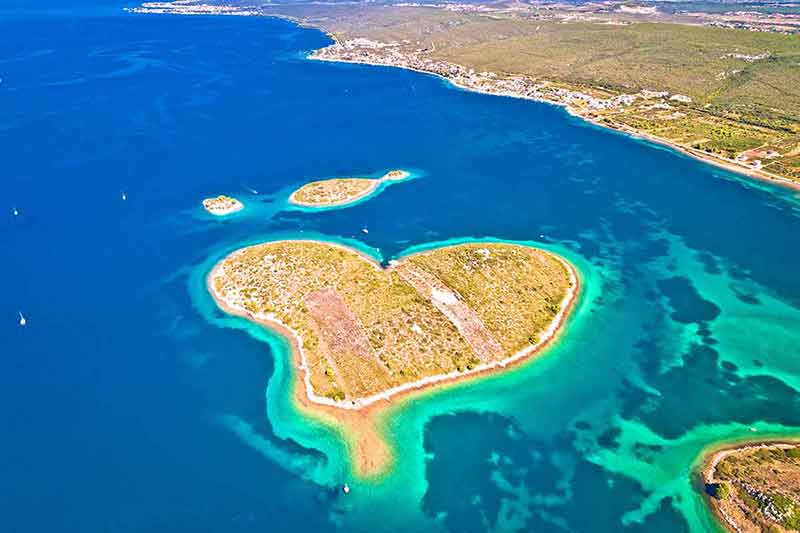
Allow yourself to enjoy the daily activity of exploring the magical marine life of the Adriatic Sea.
This sailing trip around the islands in the Zadar archipelago will allow you to explore hidden bays and underwater life, snorkel and swim in the beautiful Frnaža bay.
Check the tour below.
3- Explore Dugi Otok
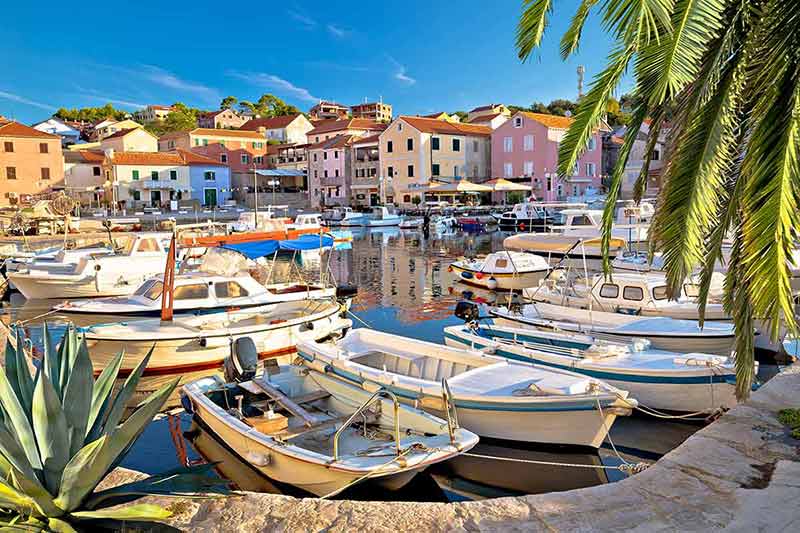
The largest island in the Adriatic Sea, with the same name as the famous cocktail, is in the Zadar archipelago.
The island is quite long, as the name says, around 45 km, and is known for its olive trees, vineyards, beautiful pebble beaches, and Telaščica Nature Park.
One of the most famous beach oases is placed there.
You will relax all your senses at the Saharun beach, with the clear sea, sound of crickets and vitamin D in abundance.
The place where all your problems will be forgotten, this boat tour will allow you to enjoy this unique experience fully.
4- Explore Ugljan
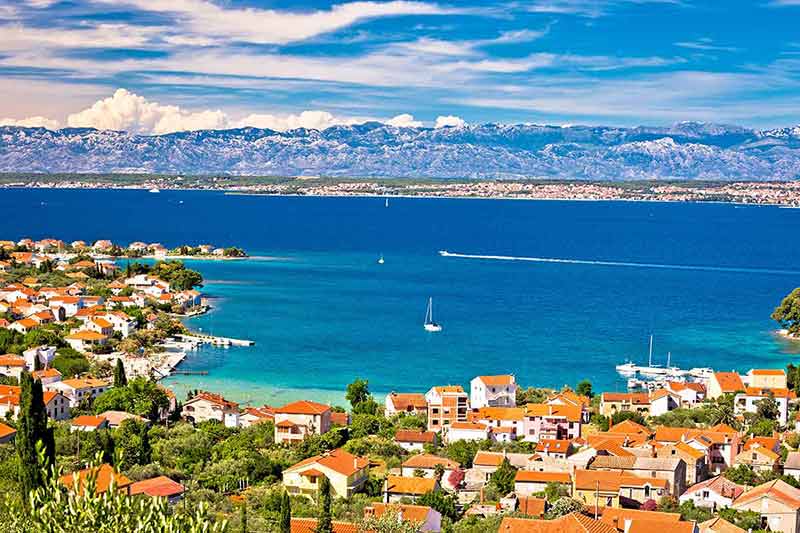
Ugljan is an island of oil and only a few minutes by ferry.
It’s home to a replica of an ancient oil mill from the 1st century where Liburnian oil was kept.
During that era, the mill produced the finest olives in Dalmatia, which was kept in the sea to give it its flavour.
Besides the finest oil, this small, peaceful island can offer beautiful beaches, rich nature, and delicious food.
Check the tour here
5- Explore Krka Waterfalls
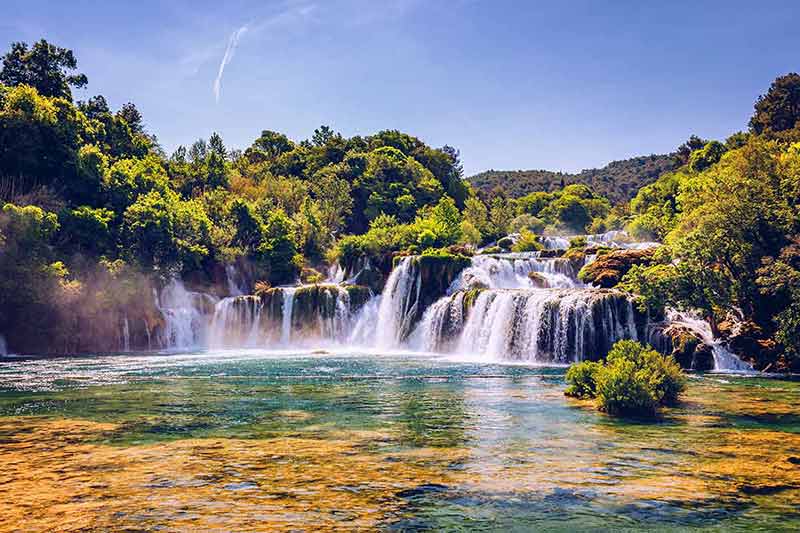
Between Zadar and Šibenik, this beautiful national park is a must-visit place.
The Park is home to over 800 plants, over 200 bird species, and around 18 bats.
One of the main highlights is Skradinski Buk, which has 17 waterfalls higher than 45m plunging into the cold river Krka.
Not so long ago, swimming in Krka was possible, but in 2021 it was banned for safety and ecological reasons.
Other gems are Roški Slap and Visovac, a beautiful small island in the middle of the Krka River.
It’s a peaceful oasis where Franciscan monks built their monastery dating back to the 15th century.
Roški Slap has 15 waterfalls, untouched, colourful nature, and stunning panoramic views.
One of the lesser-known facts is that Krka-Šibenik had the first alternating-current electric power system in Croatia and one of the first multiphase alternating-current systems in the world. Book your tour here.
6- Listen To The Music Of The Sea Organ
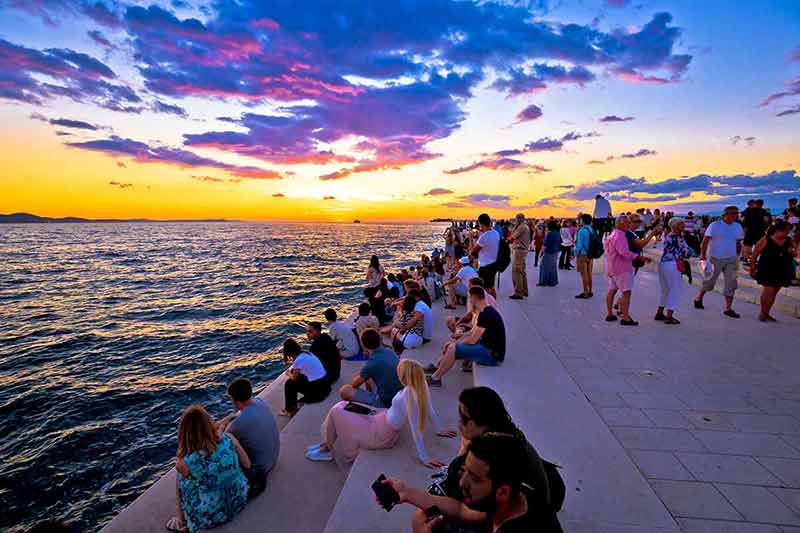
Have you ever wondered how the sea sound when it sings?
The Sea Organ is an urban architecture that catches the sound of waves and converts it into lovely notes.
It’s a unique sound that depends on the waves and the wind to create poignant and mournful music.
The sound comes from 35 polyethylene pipes different in length and size that can ‘play’ seven chords in five tones as the air passes through them.
The pipes are positioned within the stone stairs on the southern Zadar promenade, where the waves and winds are the strongest.
7- Admire The Greet Of The Sun
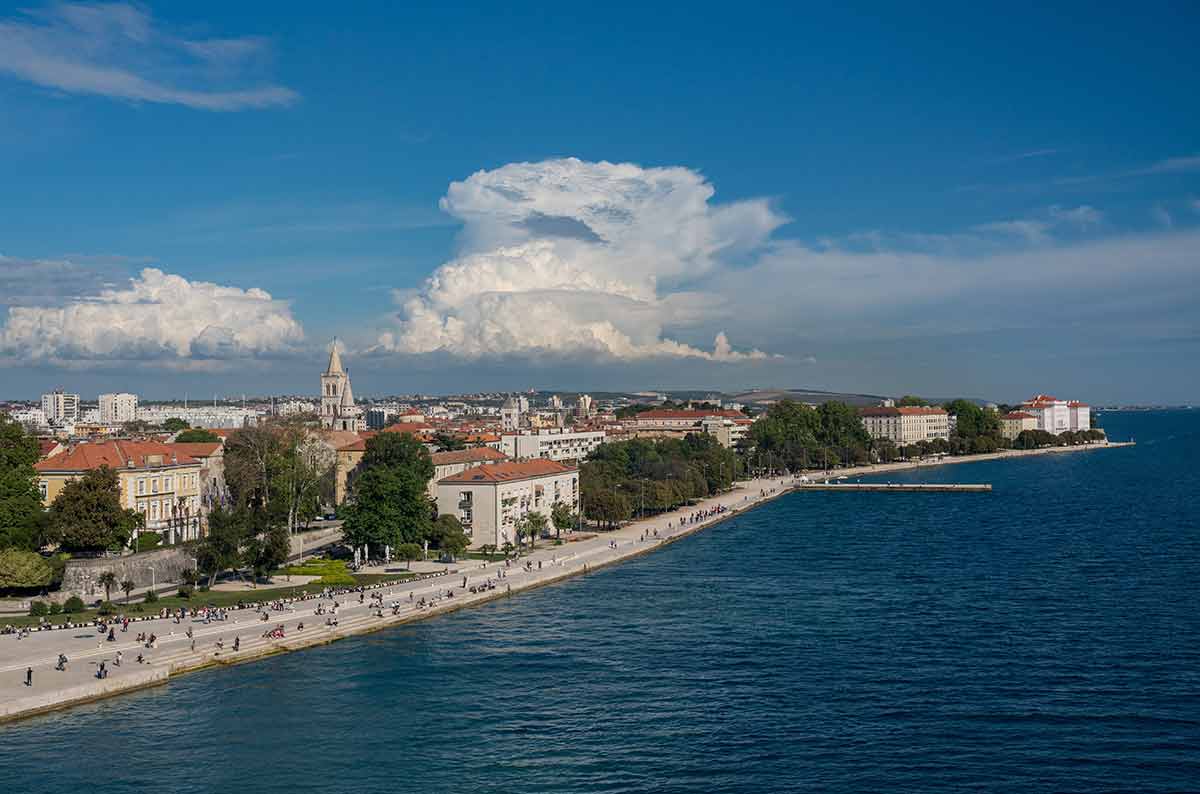
Another stunning piece of architecture designed by Nikola Basic is Greeting of the Sun, an installation of 300 photo-sensitive glass plates which absorb the sun’s energy and transforms it into an amazing light show during the night.
This place, along with the Sea Organ, is one of the top sites in Zadar.
You can enjoy the sunset with the interesting music of the waves, and when the night falls, prepare yourself to be amazed by the magical, colourful show.
In the installation frame, you can find the feast days and the coordinates of 36 saints that have been worshipped in Zadar’s churches.
8- Discover Donat
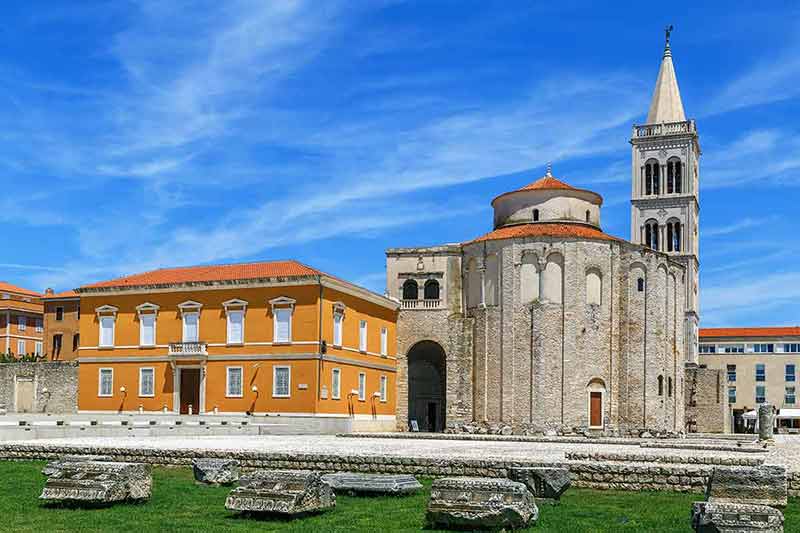
One of the symbols of Zadar city is the church St. Donat, built on the remains of an ancient Roman forum, carrying the name of the bishop St. Donat.
It’s a very simple monument in ancient Roman style, built in a circle with two rings.
Due to the excellent acoustic, since 1960, it’s been a venue for concerts of Middle Ages, Renaissance and early Baroque music.
9- Admire The Architecture Of Stošija Cathedral
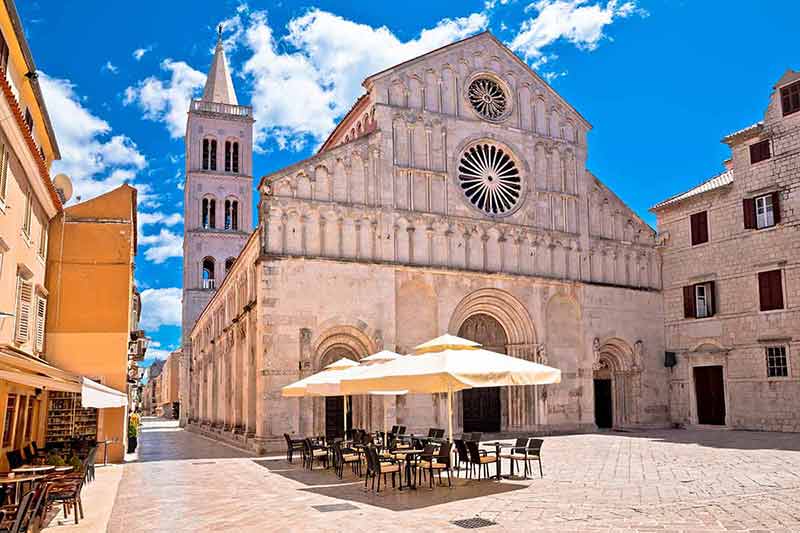
Another symbol of the town Zadar is the catholic cathedral of St. Stošija, dating from the 12th and 13th centuries.
The cathedral was built in the ancient Roman style, with influences from the Romanesque and Gothic eras.
It’s the biggest cathedral in Croatia, massive, with a big bell tower that offers a stunning panoramic view of the whole city.
The tower has around 180 steps, which are a bit steep and tight, but the view is worthwhile.
The entry price is 2 euros.
10- Roman forum
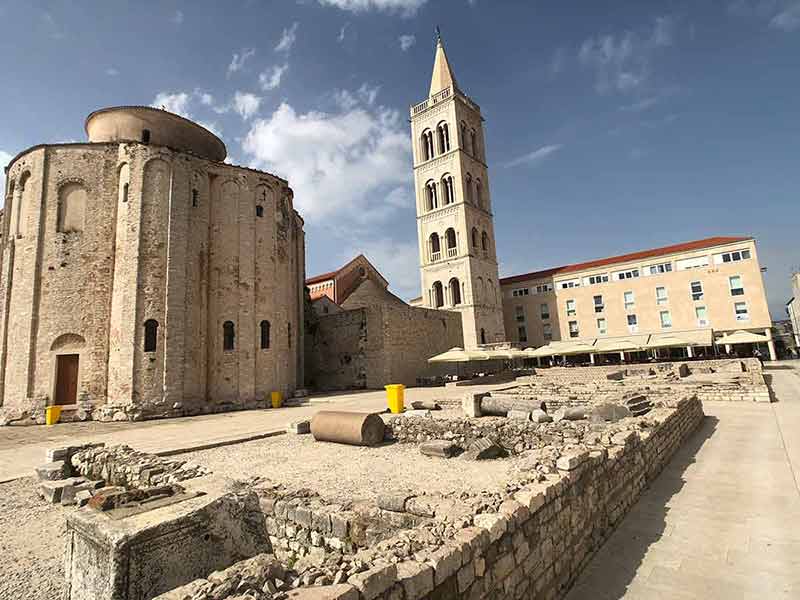
Placed in front of the church of St. Donat, the Roman forum represents the ancient city, with the remains of buildings, in the same layout.
It was built between the 1st century BC and the 3rd century AD.
All activities were held in the Roman forum, including social gatherings and political discussions.
It was the largest centre of public life on the east coast of ancient times.
In the 6th century, a violent earthquake destroyed buildings.
Later on, it was renewed in a renaissance style. Today it’s a place where many concerts, films, and other events are held.
11- Visit Providur Palace
The monument that dominated the east side of the Old Town is Providur Palace, which dates back to the 17th century.
It was known as the city hall and the residence of the providur.
Providur is an Italian/Venetian word meaning a high government official in the medieval states of the Apennine Peninsula.
The Palace consists of Providur and Kneževa Palace, and today is a national and cultural centre that’s home to the city library and concert hall.
12- Discover The Secrets Of Zadarski Bedemi
Zadarski Bedemi is an important fortification system of the town of Zadar that is the symbol of freedom and the rebel spirit of the old times.
They were built during the 12th and 13th centuries and later renewed in the 16th century when they were needed in defence against Venetians and later Turks.
They are also called Bedemi Zadarskih pobuna, which, when directly translated, means ‘the Walls of Zadar Rebel’ in remembrance of the bloody riots where the citizens of Zadar rose up against Venetian authorities.
13- See The Artistry In The Museum Of Ancient Glass
The archeological museum of glass is a unique collection of over 5000 various glass objects dating from the 1st century BC to the 5th century AD.
There are several organised workshops during the year, like glassblowing, free-blowing, and making jewellery with a torch and souvenirs in the fusing technique.
The museum also holds exhibitions, lectures, book presentations, and films about glassmaking.
The tickets cost 6 euros and for schoolchildren 3 euros.
14- Explore Telaščica Nature Park
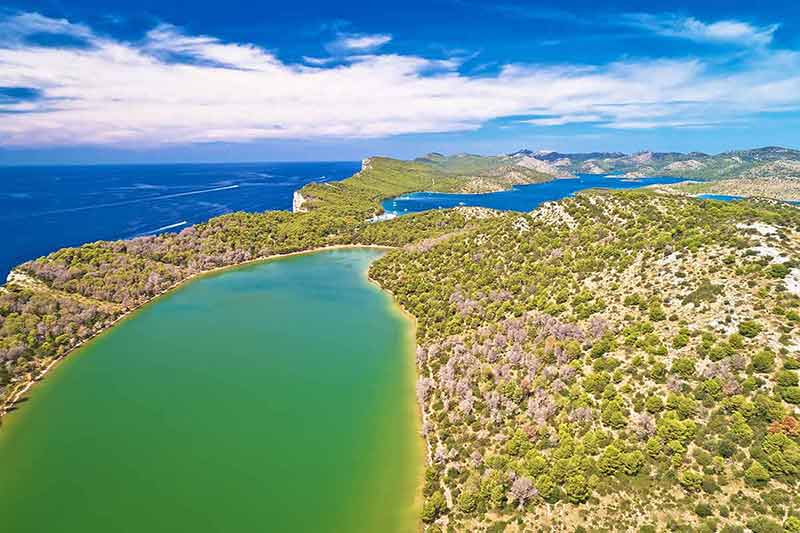
This natural gem is in the southeastern part of the Dugi Otok, surrounded by 13 islands and islets, along with six islets inside the bay, it stands out with its beauty and rich nature.
It has peaceful beaches, surrounded by steep cliffs, Aleppo pine, oak trees, vineyards, and olive trees.
It’s blessed with more than 2 500 sunny hours a year and a mild climate.
Besides stunning nature, Telaščica is home to historical treasures, like Romanesque churches, old monuments and panoramic views.
15- Discover Nature In Paklenica National Park
Paklenica National Park is 50 km from Zadar and is surrounded by the massive Velebit Mountains, with rich, green vegetation and hidden caves.
It consists of Big and Small Paklenica, with its highest peak being Vaganski at 1757 m (5765 ft) high.
The park is perfect for adrenaline lovers and nature enthusiasts keen on slower-paced activities, as there are many hiking trails, cycling trails and outdoor climbing options.
Besides geological jewels, the park has a diversity of flora and fauna.
Different types of birds, deer, bears, foxes and wild cats can be found in the park.
The educational centre of Mala Paklenica gives information about endangered bird groups, such as owls.
16- Ride A Barkajol
From early morning until late evening, these small local boats transport passengers from the land to the islands in the Zadar archipelago.
It’s a tradition of more than 3000 years, which has been transferred from generation to generation and a ride in a barkajol is one of the must-do things in Zadar.
17- Explore The Archeological Museum
This archeological museum is among the oldest museums in Europe and the second-oldest in Croatia.
It has items from the Old and New Ages, the Metal, Roman and Byzantine eras.
Most of those remains represent the spiritual and material heritage of Croatia.
On the first floor, you can see how life in northern Dalmatia was in Roman times, while the second floor shows prehistoric archeological remains from the Stone and Metal Ages.
The museum has over 100,000 different archeological items from the Paleolithic to the end of the 15th century.
18- See The Salt Works In Nin Solana
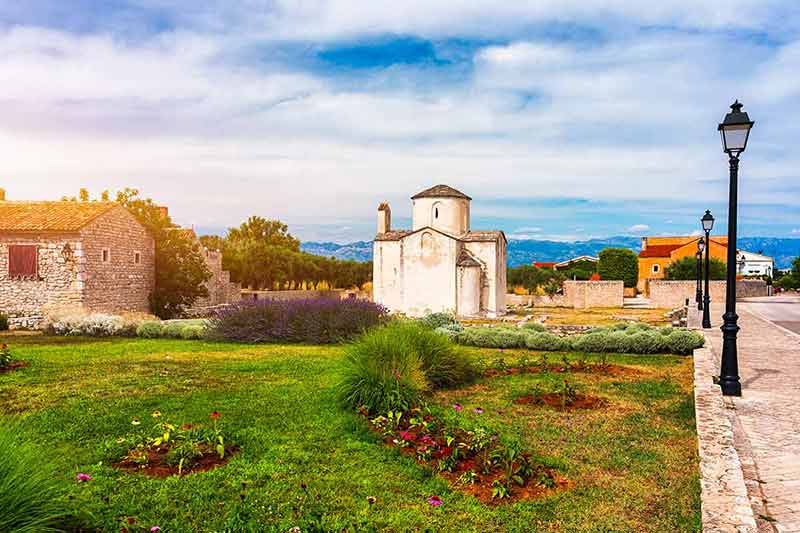
17 km from Zadar, you can discover how the production of salt works in a completely traditional and natural way.
Solana Nin is one of the biggest salt works in Croatia, supplying most of the country with salt from the Adriatic Sea.
The salt is processed in the salt pans and is transformed into different products.
19- Explore The Streets Of Varoš
The narrow, medieval streets of Varos are delightful to explore and to see daily scenes of life in Varos as people gather and feast.
It’s an area where you’ll find many restaurants and coffee shops.
20- See Krešimir Čosić Hall
This large sports centre was built as a basketball centre but serves other indoor sports, venues, and entertainment activities today.
It got its name from the famous Croatian and world basketball star Krešimir Čosić.
The hall was used for a World Handball Championship in 2009.
21- Wander Around Five Wells Square
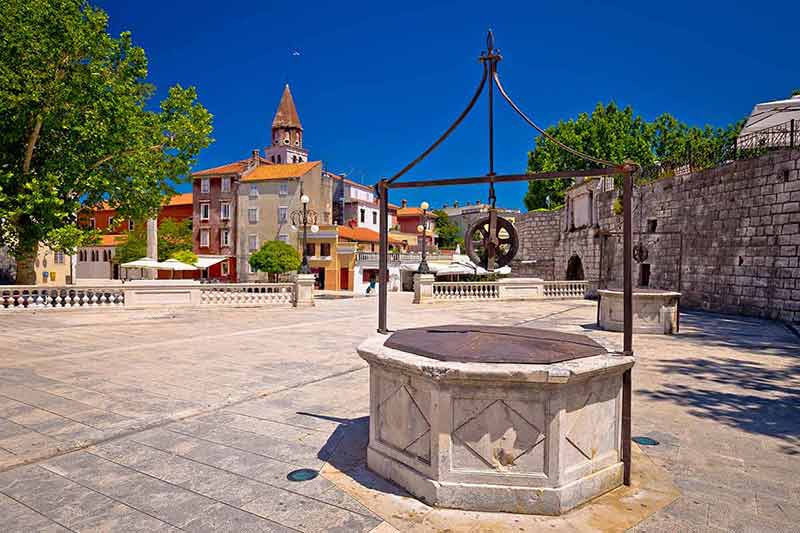
Five Wells dates from the 16th century to the Ottoman Empire.
During that time, a huge ditch was built, which later was turned into a big cistern for the water with these five wells.
Along with the five wells in the Renaissance-style square, you can see a big ancient wall and the 26 m Captain’s tower.
The square is one of the main gathering places in Zadar.
Credit: Source link




